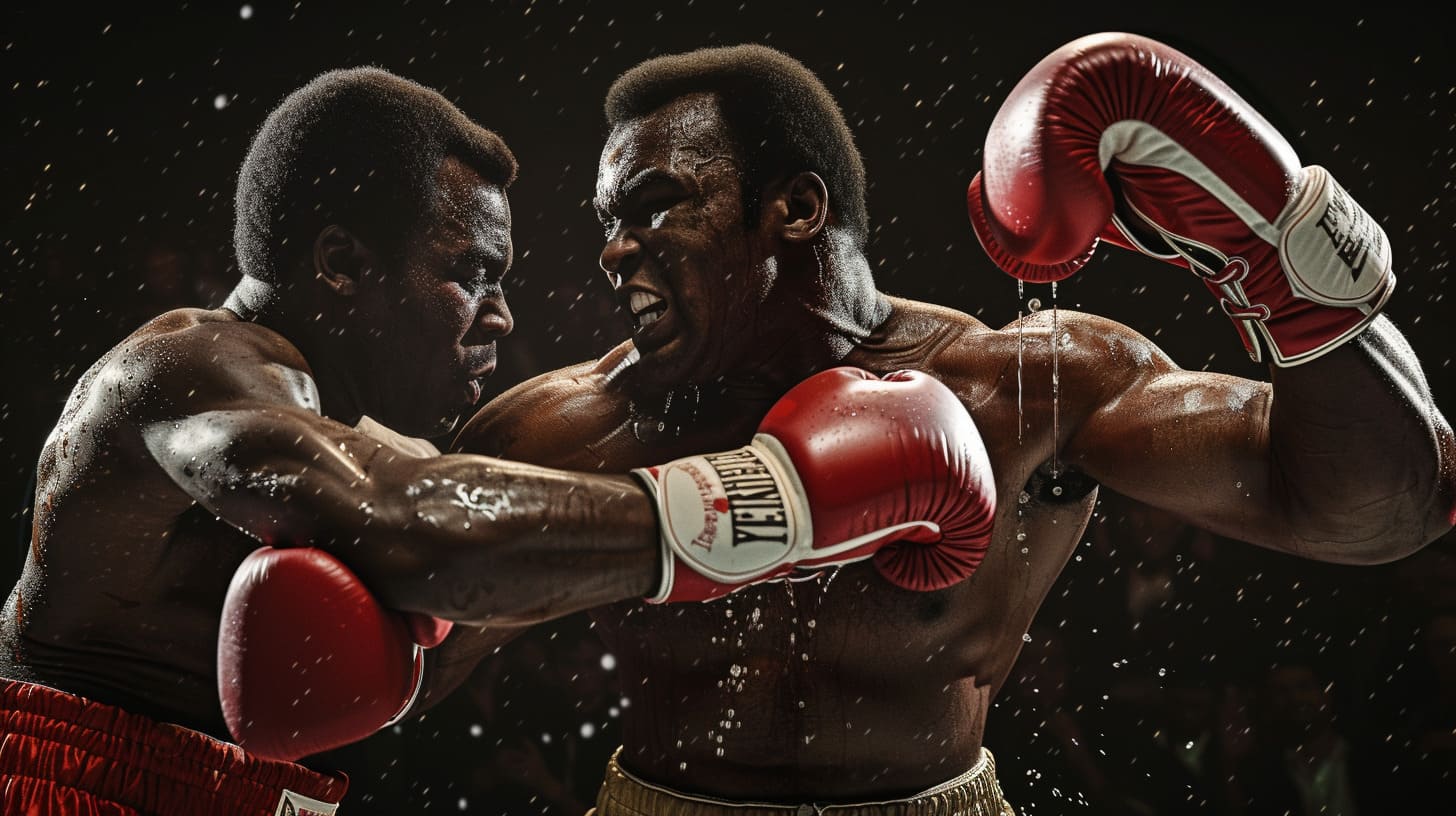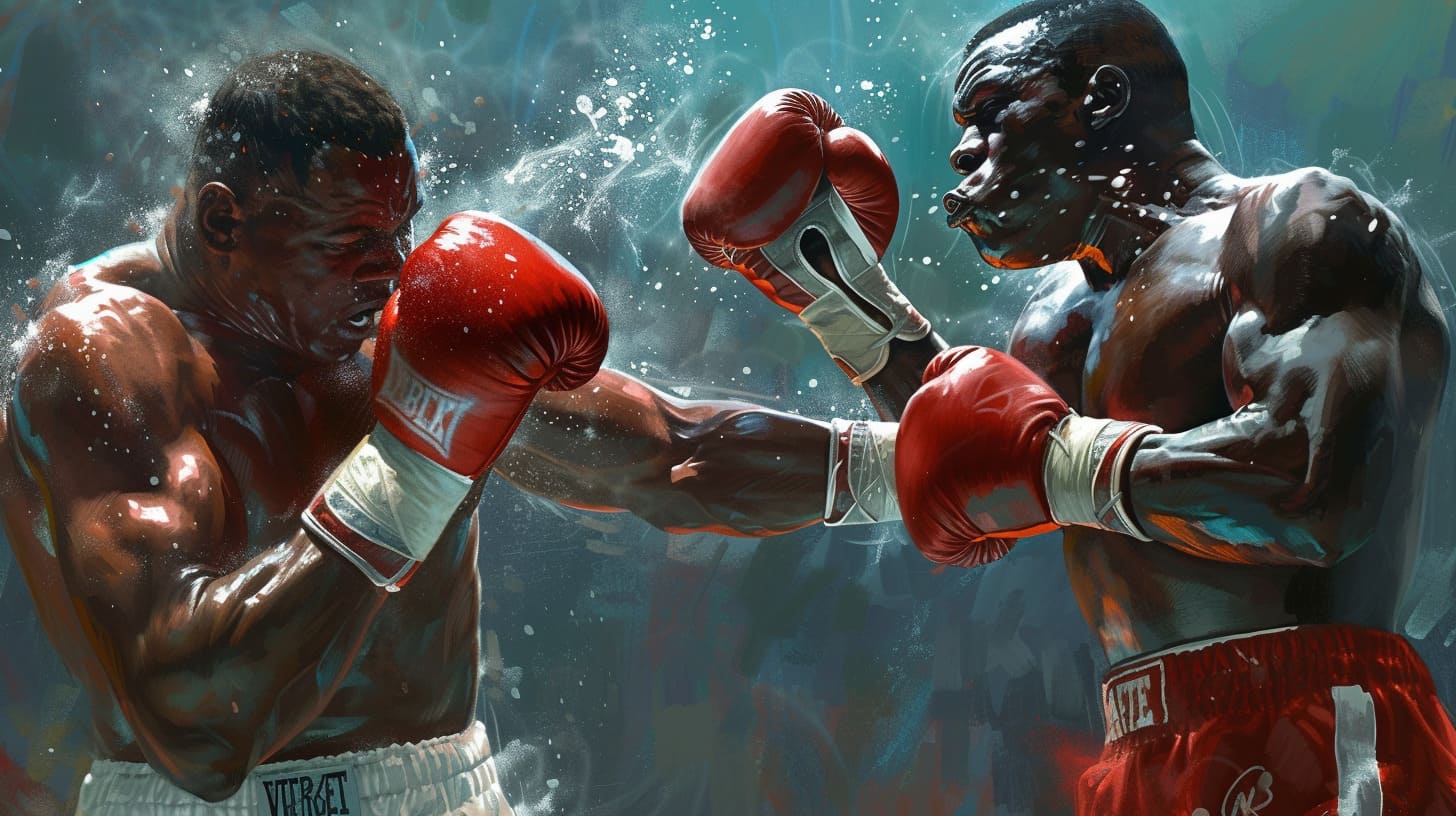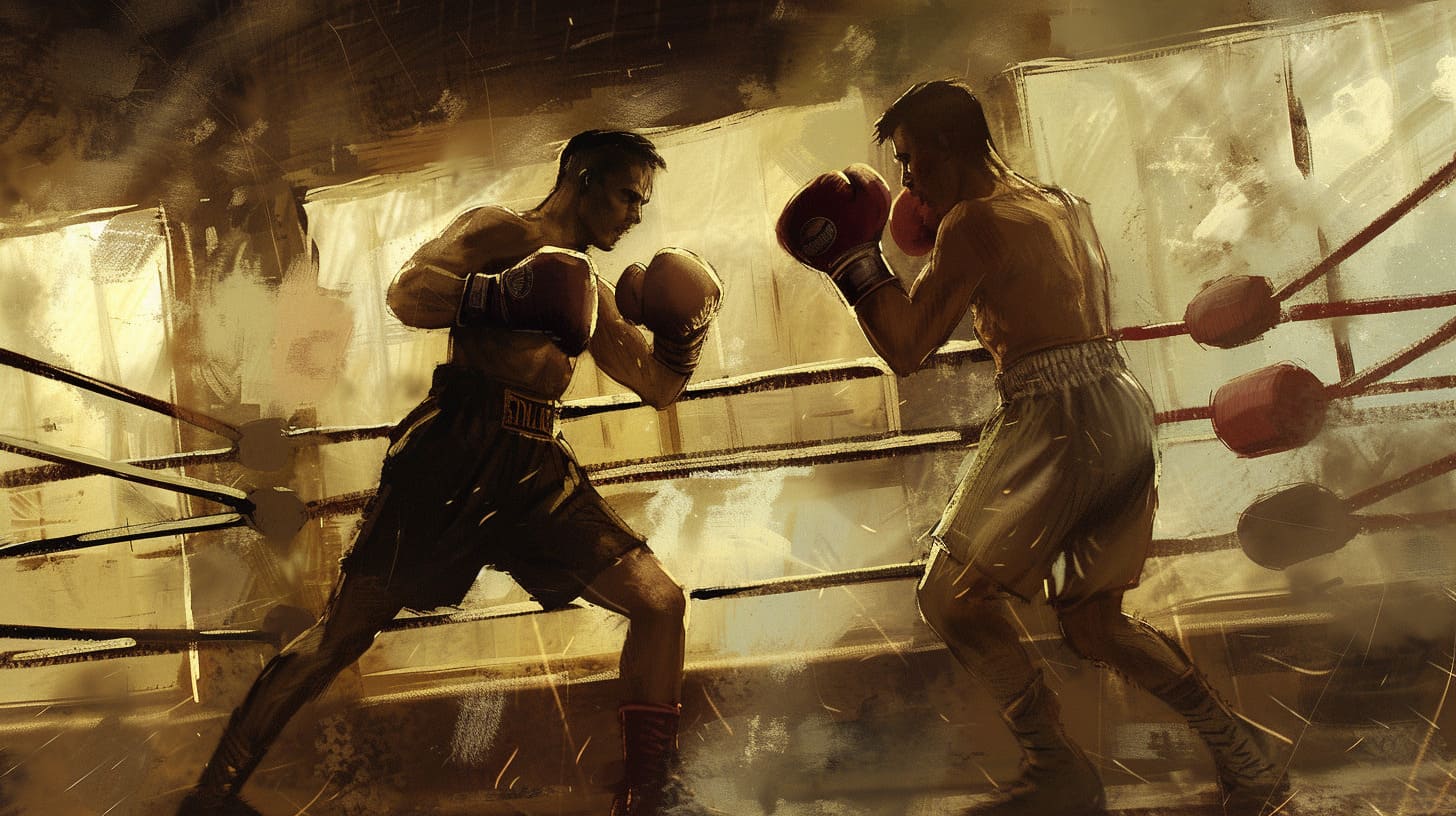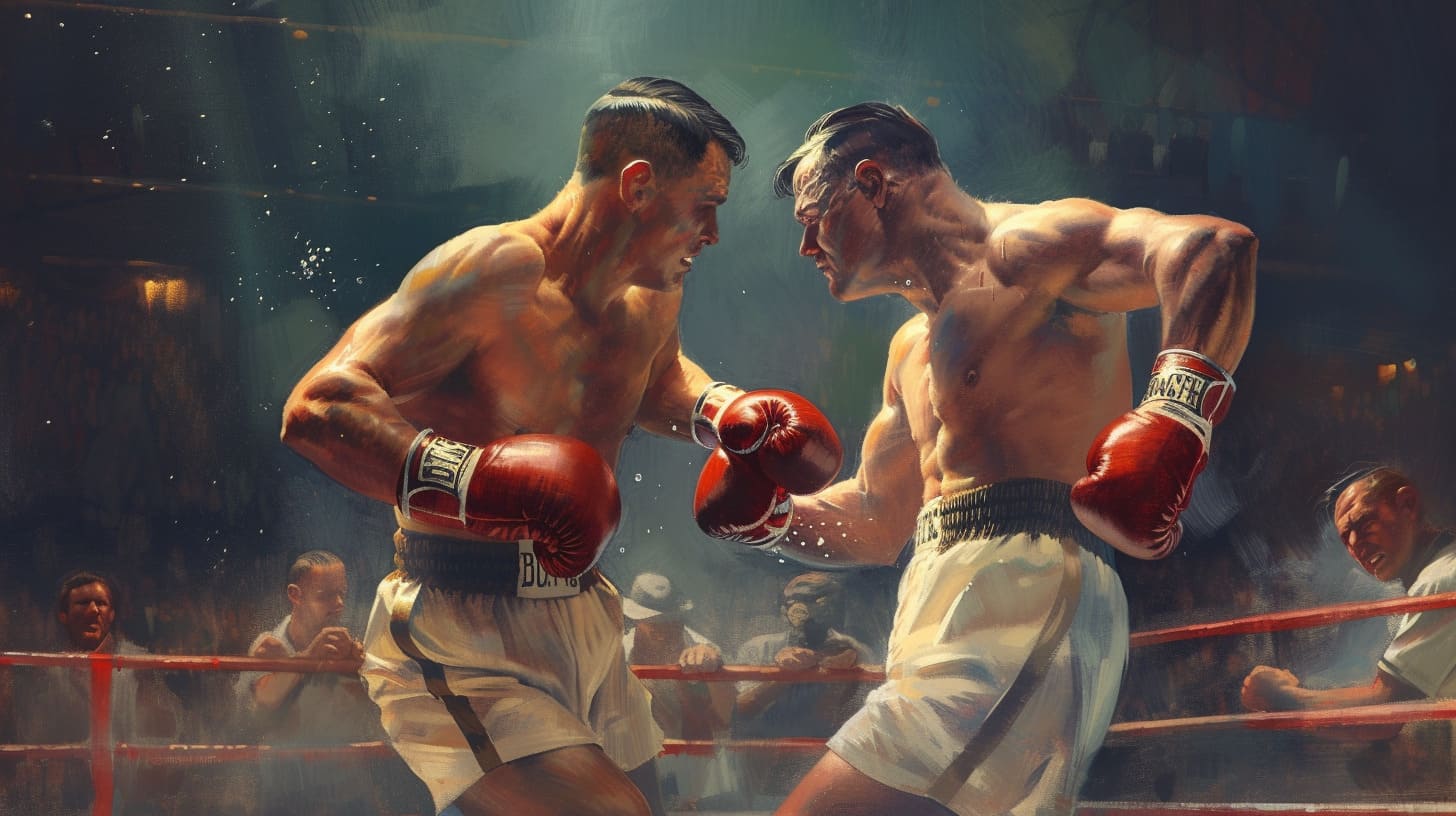Old boxing style, also known as classical boxing, harks back to a time when the Sweet Science was as much about finesse and form as it was about ferocity. Step into the ring of history as we explore the graceful art of pugilism that laid the groundwork for the modern sport. Whether you’re a boxing enthusiast looking to understand the roots of your favorite sport or just curious about how boxers used to square off in the golden days, you’ll find that old boxing style flaunts a rich tapestry of technique and tradition.
Core Principles and Techniques
The essence of the old boxing style is elegance and efficiency. Back in the day, boxers relied on the following key principles:
- Precision: Instead of relying on brute force, boxers focused on precise, well-timed hits.
- Defense: A strong emphasis was placed on dodging and parrying opponent’s strikes.
- Posture: Boxers maintained an upright posture to maximize both offense and defense.
Let’s break down these classics:
Stance
The stance used in old boxing style is quite distinctive. Here’s what it typically involved:
- Body Position: Boxers often stood side-on to minimize the target area.
- Weight Distribution: Weight was balanced more evenly between the front and back legs.
- Hands Position: Fighters kept their hands higher and closer to their faces.
Contrast this with the more squared stance of modern boxers, who tend to distribute their weight forward for power and speed.
Footwork
Footwork in old boxing style was all about grace and strategic positioning. Boxers would:
- Step and Slide: Move with small, calculated steps to maintain balance.
- Pivot: Use pivoting to create angles and evade attacks.
- Control Distance: Master the art of staying just out of reach, then closing in for swift attacks.
Whereas today’s boxers might be more aggressive and dynamic with their movements, tradition called for a more measured approach.
Guard
The guard in the old boxing style served as both a shield and a window to counter-attack. Here’s what set it apart:
- High Guard: With hands up and elbows in, boxers protected their head and body.
- Tight Defense: Rather than wide blocks, old-school fighters used tight, concise movements to deflect shots.
By contrast, modern guards can be more varied, with some fighters choosing to keep their hands lower to bait opponents.
Differences from Conventional Boxing Techniques
Old boxing style is like the ancestor of today’s bustling boxing scene. Here are a few contrasts:
- Offensive Actions: Traditional boxers favored straight punches over hooks and uppercuts.
- Defensive Maneuvers: Standard blocks and slips have evolved from the tight parries and strategic side-steps of yesteryear.
- Pace: The old style had a slower, more methodical pace compared to the fast and furious tempo of contemporary boxing.
| Old Boxing Style | Conventional Boxing |
|---|---|
| Side-on Stance | Squared Stance |
| High, Tight Guard | Varied Guard Positions |
| Precise, Timed Hits | Combination of Speed and Power |
| Calculated Footwork | Aggressive Footwork |
It’s a blend of art and sport that shaped the boxing of today while maintaining its own unique charm. Knowing how it all started offers us not only a historical insight but also enriches our appreciation for the complex, dynamic nature of modern boxing.
Signature Moves & Strategies in Old Boxing Style

Old boxing style is like a throwback to the raw beginnings of the sport—a time when technique, toughness, and tenacity spoke volumes in the ring. Let’s delve into the iconic moves and strategies that made the fighters of yesteryear legends, and see how they still resonate with the boxing techniques of today.
The Classic Stance
Imagine the black-and-white footage of a bygone era, where boxers stood with a unique poise that spelled the beginning of an epic bout. The old boxing style was characterized by a particular stance that laid the groundwork for both offense and defense.
- Wide-legged Stance: Providing a sturdy base.
- Hands Held High: To guard against facial blows.
- Elbows Tucked: Protecting the body and ready to unleash uppercuts.
Greats like Jack Dempsey mastered this stance, holding his ground and foreboding the onslaught he was about to unleash on his opponents. This posture wasn’t just for show; it was a dynamic starting point from which fighters maintained balance while delivering and dodging punches.
The Demoralizing Body Blow
In the old boxing style, body blows were a quintessential part of a boxer’s arsenal. Targeting the opponent’s midriff could sap their strength over the course of the bout, making it a technique of attrition.
- Liver Shot: A hook to the body that could incapacitate.
- Solar Plexus Punch: Straight punches to the midsection, disrupting breathing.
- Kidney Punch: Though now illegal, these were once a go-to move to wear down an adversary.
A fighter like Harry Greb, “The Pittsburgh Windmill,” was infamous for his relentless body attacks, breaking down his opponents with persistent and powerful shots to their body, proving the effectiveness of a well-aimed blow to the core.
The Art of ‘In-Fighting’
When we talk about old boxing style, we can’t overlook the intimate dance of ‘in-fighting’. This close-quarters combat style was about outmaneuvering and overpowering your opponent from a position where there is little room to move.
- Clinching: Not just a rest period but a tactic to smother the opponent’s attacks.
- Short Hooks and Upper Cuts: Designed to be effective at a close range.
- Bobbing and Weaving: Making a boxer a difficult target even at arm’s length.
Fighters like Joe Frazier thrived on in-fighting, bobbing into the danger zone to land explosive hooks that often spelled the end for his rivals. This was the bread and butter of his strategy—get in close, make them uncomfortable, and hit them hard.
The old-school boxing moves and strategies give us a glance into the past when every fight was a testament to the boxer’s skill and determination. These techniques have set the foundation for modern boxing, and the legends who employed them remain an inspiration to fighters and fans alike. Whether the fighters of today realize it or not, echoes of the past are always present in the corner of every boxing ring.
Challenges and Limitations of Old Boxing Style

Stepping into the ring, it’s crucial to know what you’re up against—especially when it comes to the old boxing style. It’s got its charms, but no fighting technique is without its hurdles. Let’s strip down the glossy veneer and take a hard look at where this classic approach might hold you back.
The Benefits of the Old Boxing Style
Old school boxing is not just a relic of the past; in many cases, it’s still a secret weapon! When a boxer taps into the essence of this style, they’re wielding a timeless toolset that can baffle even the shrewdest opponents. Check out a few situations where the old boxing style shines brightest:
- Working The Jab: This style focuses on a crisp, powerful jab that can control the pace of the fight.
- Footwork and Finesse: Old school boxers move with a purpose, maintaining balance and creating openings.
- Defense is Key: The high guard and tight footwork make it tricky for opponents to land clean shots.
- Psychological Edge: Employing a tested and respected style can mentally intimidate or throw off competitors.
- Stamina Management: This style emphasizes efficiency, helping a fighter conserve energy throughout the rounds.
When a boxer goes retro, they’re bringing more than just punches to the bout; they’re channeling the tricks and tactics of the greats. Now, that’s a heavyweight advantage!
The Drawbacks of the Old Boxing Style
However, every boxing stance has its achilles’ heel. When rival fighters read the manual on old school boxing, they might just figure out how to turn the tables. Here’s a rundown of when the bell might toll for the classic form:
- Predictability: Relying on foundational tactics can become a pattern that keen fighters will exploit.
- Power Punch Limitation: Old school boxing can be less about power shots, which might be less intimidating in a slugging match.
- Speedsters May Outpace: Faster, more agile boxers can potentially outmaneuver the deliberate style of old school boxing.
- Adaptability: Modern fighting techniques are continuously evolving, and sticking to a single style may hinder adaptation.
- Range Awareness: Boxers who dominate at a distance might find the close-quarter preference of old school limiting.
No matter how timeless a fighting style may be, the ring is always evolving. It’s crucial to adapt and mix in a little modern flair with the classic to stay on top of your game. After all, boxing is as much about the evolution of strategy as it is about landing the knockout punch.
Defending against old boxing style
Navigating the ring with someone who’s got that old-school boxing groove can really throw you for a loop. Let’s dive into the nitty-gritty of how you can bob and weave like a pro when you’re up against a boxer who dances to the rhythm of the past.
Boxers from the yesteryears often leaned on a more upright stance and favored tight, compact movements. This can make your usual feints and flurries less effective. To outmaneuver an old boxing style, you’ll want to consider a few key defense strategies.
Keep Your Guard Up and Tight
With shorter, sharper punches being a hallmark of vintage pugilism, maintaining a solid guard is essential. Don’t get sloppy—your hands should be ready to protect against jabs and crosses at a moment’s notice.
Maximize Your Footwork
In the ring, your feet are your best friend. They can get you into a good position and, more importantly, out of a tight spot. Light, nimble footwork can help you stay out of range from those textbook straight shots iconic to the older styles.
Counterpunch with Precision
Timing is everything when you’re dealing with someone adhering to the old boxing style. They’re about the basics, so mastering the art of the counterpunch can really pay off. Wait for them to commit, and then make your move with surgical precision.
Now, let’s hit you with some additional practical tips to keep you floating like a butterfly.
- Master the Art of the Parry
- Redirecting your opponent’s punches can minimize the impact and set you up for a counter. Watch for patterns in their offense to anticipate and parry effectively.
- Focus on Angles
- Don’t be a stationary target. Move at angles to open up opportunities for counterattacks and to keep your opponent guessing.
- Develop Your Clinch Game
- When the distance closes, and you find yourself toe-to-toe, a well-timed clinch can disrupt their rhythm and give you a momentary breath.
Remember, the key to successfully defending against an old boxing style is to blend respect for the past with modern agility and strategy. Keep these tips up your sleeve, and you’ll be more than ready to turn the tables on tradition and come out on top.
Notable Practitioners of the Old Boxing Style
When you think of boxing, what often comes to mind is the intense action and the legendary figures who have defined the sport. Certain boxers not only clinched titles but also left a lasting impact with their unique approach to boxing. Let’s dive into three iconic practitioners who are celebrated for their mastery of the old boxing style.
1. Jack Johnson

Jack Johnson, affectionately known as the “Galveston Giant,” was a trailblazer in the sport of boxing. He became the first African American world heavyweight boxing champion in 1908, a time fraught with racial tension and challenges, holding onto the title until 1915.
- Career Highlights:
- First African American World Heavyweight Champion
- Defended his title multiple times
- Contributions to the Style:
- Pioneered a more defensive style, emphasizing footwork and patience
- Known for his ability to dodge and wear down opponents
- Memorable Fight:
- His victory over James J. Jeffries in 1910, dubbed the “Fight of the Century,” is a hallmark moment where his defensive prowess was on full display.
2. Willie Pep
Next up is Willie Pep, a name synonymous with artistry in the ring. With an incredible record of 229 wins in his career, Pep was known for his swift movements and finesse that epitomized the old boxing style.
- Career Highlights:
- Two-time World Featherweight Champion
- One of the few boxers to win over 200 fights
- Contributions to the Style:
- Master of footwork and head movements
- His strategies revolved around outsmarting rather than overpowering the opponent
- Memorable Fight:
- His fight against Sandy Saddler in 1949 showcased Pep’s slick defensive maneuvers, though he lost, the match remains a testament to his skills.
3. Joe Gans
Joe Gans, often dubbed the “Old Master,” is a key figure in boxing history. As the first African American World Lightweight Champion, his career spanned from the late 19th century into the early 20th century, a remarkable feat during an era of intense racial discrimination.
- Career Highlights:
- World Lightweight Champion (1902-1908)
- Successfully defended his title 14 times
- Contributions to the Style:
- Renowned for scientific boxing and technical prowess
- Innovated strategies that would influence modern boxing techniques
- Memorable Fight:
- His 42-round marathon against Battling Nelson in 1906 where his endurance and skill led to a historic victory.
These exceptional athletes have cemented their names in the annals of boxing history, each bringing their distinct flavor to the old boxing style. Their careers, achievements, and the elegance of their form in the ring continue to inspire and teach lessons in the sweet science of boxing to this day.
Training and Conditioning for Old Boxing Style

Getting into the groove of an old boxing style isn’t just about throwing punches; it’s an art that requires a blend of old-school discipline and conditioning. If you’re intrigued and ready to adopt this classic boxing flavor, you need a roadmap—here are the drills and exercises that’ll transport you back in time to the golden days of boxing.
Specific Drills for Old Boxing Style
Training for an old boxing style emphasizes the basics—footwork, balance, and technique. To get started, let’s put your muscles to work with some timeless drills:
- Footwork Ladder Drills:\ Traditional boxers had impeccable footwork. To improve yours, use a footwork ladder to practice agility drills. The in-and-out and side-to-side movements will build coordination and speed, vital for the old-school ring dance.
- Heavy Bag Work:\ Incorporating a heavy bag into your routine builds power and endurance. Stick to basic combos and focus on body positioning to perfect your form as the greats did.
- Sparring Sessions:\ Nothing beats the old-fashioned sparring to get a real feel of the boxing style. Start with light sparring to focus on defensive maneuvers and strategic thinking.
- Speed Bag Drills:\ The speed bag was a staple in any traditional boxer’s training regimen. It improves hand-eye coordination and rhythm—key components of the old boxing style.
- Double-End Bag:\ To fine-tune accuracy and timing, the double-end bag is your best friend. This moving target mimics an opponent’s movements, helping you to anticipate and counter-attack with precision.
Exercises Tailored to Old Boxing Style
The training doesn’t stop with drills. Specific exercises help condition your body:
- Roadwork: Go for a run! Old-timey boxers swore by roadwork for building stamina. Start with 2-3 miles at a moderate pace to condition your body.
- Calisthenics: Think push-ups, pull-ups, sit-ups, and squats. Such exercises build muscle endurance and strength without bulking up too much—an essential aspect of the lean and mean physique of a classical boxer.
- Jump Rope: It’s a simple yet effective way to improve cardiovascular fitness and imitate the on-your-toes movement required in the ring.
Additional Tips for Mastering Old Boxing Style
- Master the Basics: Before you worry about flair, get your basics down cold. Technique is everything in old boxing style.
- Watch the Greats: Study footage of legendary boxers. Pay close attention to their movements, strategies, and how they adapt to opponents.
- Mind Over Matter: Mental toughness was key for boxers back in the day. Work on your mental game by staying calm and strategic during sparring sessions.
- Conditioning Is King: Never skimp on your conditioning work. Great conditioning translates into better movement, stronger punches, and more rounds in the bag.
- Rest and Recover: Take rest as seriously as you take training. The old-timers understood the value of recovery, so give your body enough downtime to heal and strengthen.
By integrating these drills, exercises, and tips into your training, you’ll be well on your way to capturing the essence of old boxing style. Remember, it’s a marathon, not a sprint—stay dedicated, and you’ll find yourself moving and punching like the boxing legends of yesteryear. Lace up your gloves and get ready to train like it’s the good old days!
Final Thoughts
As the final bell rings on our journey through the old boxing style, we revel in the elegance and the earthy crunch of leather gloves from a bygone era. It’s a style that teaches us the virtue of precision over power, the art of a tactical dance in the ring, and the value of each careful footstep and parried blow. Embracing these timeless techniques isn’t just an ode to the ancestors of pugilism; it’s a way to enrich our own approach to the sweet science. So, whether you’re lacing up the gloves for the first time or you’re a seasoned pro, consider incorporating a hint of the old boxing style into your regimen. You’ll not only pay homage to the greats who laid the foundation for the sport but also challenge yourself with the finesse and strategy that is as relevant today as it was back then. Now, step into your own ring of life and bob, weave, and jab with the grace of yesteryear—the past champions are in your corner. 🥊
Additional Resources
Hey there, boxing enthusiasts! Ready to dive deeper into the classic craft of old boxing style? If you’re keen on expanding your knowledge beyond the jab and hook fundamentals, the following treasure trove of resources will have you dancing the ring around like a true old-school pugilist.
Books to Get You Hooked on the Old School
- “The Sweet Science” by A.J. Liebling
- A timeless classic that takes you back to the golden age of boxing with elegance and wit. Read it here!
- “Pictorial History of Boxing” by Nat Fleischer and Sam Andre
- Dive into the visual journey of boxing’s past heroes and the evolution of the sport. Check it out here!
- “Boxing: A Cultural History” by Kasia Boddy
- Explore how boxing intertwined with culture and society throughout the ages. Grab a copy here!
Engaging Articles
- “The Boxers of the Old West” on TheFightCity.com
- Get a sense of how boxing shaped up in the American frontier. Read the article!
- “The Gentleman’s Guide to the Sweet Science of Boxing” on Art of Manliness
- A refreshing look at old boxing styles with a modern twist for today’s gentleman. Check the article here!
Instructional Videos and Documentaries
- “CounterPunch” on Netflix
- A documentary that compares the struggles and triumphs of modern boxers to the legends of the past. Watch on Netflix!
- YouTube Channel: Lee Wylie Boxing
- A collection of fight analysis videos dissecting the techniques of boxing greats. Subscribe here!
- “Unforgivable Blackness: The Rise and Fall of Jack Johnson”
- Ken Burns’s deep dive into the life of the first African American world heavyweight champion. Discover the story!
Websites to Bookmark
- Cyber Boxing Zone
- A hub for historical boxing articles, biographies, and classic fight reviews. Visit the Cyber Boxing Zone!
- BoxRec
- The go-to database for fighter records, historical bouts, and detailed statistics. Explore BoxRec!
With these resources at your fingertips, you’re all set to embark on a fantastic historical boxing journey. Whether you prefer to flip through the pages of a gripping book, plunge into in-depth articles, or watch the sweat and drama unfold in documentaries and videos, there’s something that will satisfy your curiosity and love for the sport. Keep learning and keep that guard up, champ!

